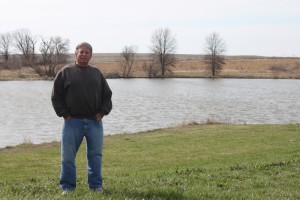
Richard Phillips uses the Conservation Reserve Program (CRP) to continue his brother’s legacy of protecting wildlife and conserving resources on the family farm near Norborne in Carroll County, Missouri.
Missouri farmer Richard Phillips lost his brother Gary in 2000. Gary had polio. Still, he was an avid outdoorsman and conservationist. A bench with Gary’s name inscribed on it sits near a pond on the farm and reminds the family of Gary’s commitment to wildlife and conservation.
The year before Gary died, he enrolled 114 acres in the USDA Farm Service Agency (FSA) Conservation Reserve Program (CRP) to help promote wildlife habitat, maintain clean water and prevent soil loss on the farm. Richard took over the operation and makes sure his brother’s legacy lives on by continuing conservation practices on the family farm.
“The motivation is trying to preserve the integrity of the farm,” Phillips said. “We’re trying to preserve the heritage, wildlife and aesthetics of the farm while preserving the overall management of the property.”
CRP, which is celebrating its 30th anniversary in 2015, is among the largest private lands conservation programs to reduce soil erosion, improve water and air quality and provide wildlife habitat.
It is a voluntary program that allows eligible landowners to receive annual rental payments and cost-share assistance to establish long-term, resource-conserving covers on eligible farmland throughout the duration of their 10-to-15-year contracts.
When Richard, a retired teacher and school administrator, took over the farm, he met with Katie Singer, Carroll County FSA program technician and Lee Metcalf, a private land conservationist with Missouri Department of Conservation. Together they drafted a plan to carry out Gary’s goals of increasing the number of bobwhite quail, pheasant, deer, rabbits and other wildlife on the farm.
The farm has 160 acres of timber and grasslands and is perfect for hunting. The CRP land along with two other nearby farms have been in the Phillips family for 135 years.
During the last 15 years, the farm has incorporated numerous specialty CRP practices as part of an overall plan to optimize wildlife habitat.
Phillips is currently working to make the farm accessible to children and families with special needs and health challenges.
Nine years ago, Richard’s oldest granddaughter was diagnosed with T-cell lymphoblastic leukemia. During her stay at Children’s Mercy Hospital in Kansas City, Richard talked to other families with similar situations. Those conversations sparked the idea of taking conservation a step further and creating a place on the farm where families with children who are enduring illness or disabilities can safely go to fish and enjoy nature.
After a couple years of planning, the Phillips family is taking the first step in making this dream a reality by installing a stable fishing platform on one of their ponds and building accessible restroom facilities. Plans are also in the works to incorporate a handicap accessible trail around the fishing pond. The trail will include CRP pollinator practices and areas for visitors to learn about the importance of farming conservation efforts.
Future plans include creating accessible areas for deer hunting and wing shooting.
Richard’s three children and six grandchildren all play an active role in the maintenance and installation of the many conservation practices. They also enjoy hunting on the property.
“(CRP) has enhanced the history of this property,” Phillips said. “It has provided a great opportunity for my grandkids and family to get together to do things. It’s enhanced our quality of life by providing opportunities that we would not have otherwise.”
Since being established on December 23, 1985, CRP has helped prevent more than 8 billion tons of soil from eroding and protected more than 170,000 stream miles with riparian and grass buffers, more than 100,000 acres of bottomland hardwood trees, nearly 300,000 acres of flood-plain wetlands, and 250,000 acres each for duck nesting habitat and upland bird habitat.
2015 marks the 30th Anniversary of CRP. For an interactive tour of CRP success stories from across the U.S., please visit the FSA CRP 30th Anniversary website at http://www.fsa.usda.gov/CRPis30.






3 Responses to USDA Conservation Program Adds Meaning to Missouri Farmer’s Legacy